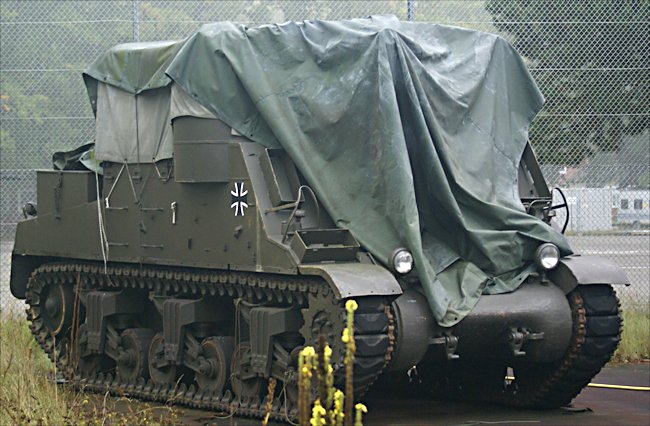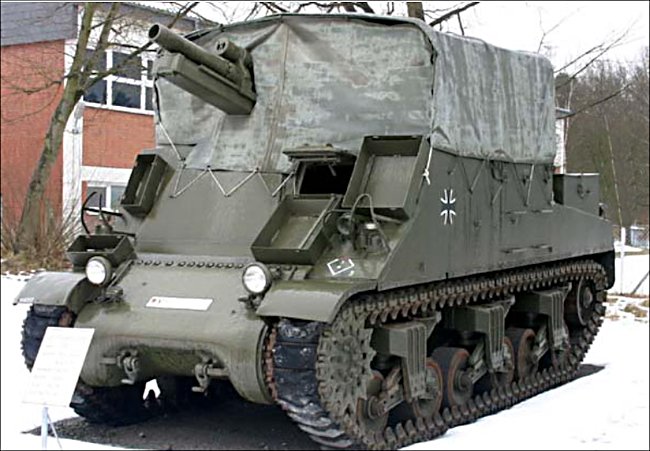M7B2 Priest 105mm SPG
This M7B2 Priest Self Propelled Artillery Gun SPG US made 105 mm Howitzer Motor Carriage can be seen at the Deutsches Panzermuseum in the small military town of Munster, Germany. It was used during the early part of the Cold War but based on the WW2 M7 Priest.

It is a M7B2 Priest (post WW2), with an elevated howitzer.
M7 Priests in Normandy 1944
On a June afternoon in 1944, under cover of a smokescreen that was to be laid down by the Navy, they were to attack the village of Pont Auny. A battleship fired two smoke shells into the area, but the smoke quickly dissipated and the attack was made in broad daylight. Sergeant Androkovich of the 712th Tank Battalion drove the lead M7 105mm Howitzer Motor Carriage between two hedgerows and into an apple orchard. Corpral Eddie Ritz was the gunner and Young the Vehicle commander, Lt Sam Adair, the platoon leader, was along for the ride.
The British called these assault guns the 105mm Self Propelled Gun, Priest. It was called the Priest because of the pulpit like machine gun ring in the fighting compartment. Records show that 3,490 Priest SPGs were built between April 1942 - 1945. It could carry 69 rounds, most were high explosive HE shells to enable it to provide direct fire support and indirect artillery barrage supporting fire.The M7 Priest had armour protection that ranged from 12mm to 60mm. It was powered by a Continental R-975 C1 340hp engine that enabled the M7 Priest to have a top road speed of 24mph (39km/h) and a cross country speed of 15mph (24km/h)

M7 B2 Priests used by the German Army during the Cold War
A camouflaged German Panzer Mark IV tank in a corner of the orchard allowed the lead M7 Priest to pass. It opened fire on the second M7. The armor-piercing shell penetrated the front of the second Priest and went out the back. A second shot sent flames shooting out the top.
In the lead M7 SPG, Young rotated the turret and Ritz fired a high-explosive shell that was in the chamber. He watched as it flew harmlessly over the German tank. The gun of the Mark IV was now pointing at Young's tank and it fired, striking the assault gun in the track. Ritz lowered the 105-mm cannon as far as it would go and fired another round. It struck the German tank just below the cannon with a shower of sparks. The tank did not catch fire, but the crew bailed out through an escape hatch and melted into the brush, Bob Atnip of Clementsville, Kentucky, was the loader in the third M7 Priest.
Young's assault gun could not move due to its broken track. Adair did not want to risk having it fall into enemy hands with a full load of ammunition and asked Ritz to stay with him and sent the remaining crew to the rear. He traversed the gun in the direction of the German lines, and with the lieutenant loading and the gunner firing, they used up most of the remaining 105 -mm shells.
When they were down to the last few rounds, Adair missed a beat in the rhythmic loading and firing, the cannon's recoil smashing his shoulder. Before retreating to the rear, Androkovich and Ritz went over to check out the German tank. The body of its gunner was inside. 'Look at this!' Ritz said. A round was in the cannon's chamber and the breech was closed. A split second more and their tank would have met the same fate as the second assault gun.
Where can I find surviving cold war M7B2 Priest?
- Auto + Technik Museum, Sinsheim Germany
- Museum für Militär und Zeitgeschichte, Stammheim, Germany
- Artillery School , Idar Oberstein, Germany
- Grafenwöhr Training Area, Grafenwöhr, Germany
- Leopold Kaserne, Amberg, Germany
- Herrenwald Kaserne, Stadtallendorf, Germany
- Barbara Kaserne, Delmenhorst, Germany
- Markgrafen-Kaserne, Bayreuth, Germany
- Nibelungen Kaserne, Walldürn, Germany
- Unteroffizier-Krüger-Kaserne, Kusel, Germany
- Lager Wilhelmswald, Baumholder, Germany
- ichthofen-Kaserne, Dedelstorf, Germany
- Freiherr-vom-Stein-Kaserne, Coesfeld, Germany
- Generalfeldmarschall-Rommel-Kaserne, Augustdorf, Germany
- Schlieffen-Kaserne, Lüneburg, Germany
- Liliencron-Kaserne, Kellinghusen, Germany
- Truppenübungsplatz, Putlos, Germany
- Artillery Museum, Brasschaat, Belgium
- Musée des Blindés, Saumur, France
- Artillery Museum, Draguignan, France
- Schweizerisches Militärmuseum, Full, Switzerland
- Heeresgeschichtliches Museum, Wien, Austria
- Burstyn Kaserne, Zwölfaxing, Austria
- Coonskin Park, Charleston, WV, USA
- West Virginia National Guard, Point Pleasant, WV, USA
- Fort AP Hill Historical Collection, Fort AP Hill, VA, USA
- Sanford, NC, USA
- Dillon, SC, USA
- Davison, MI, USA
- Ropkey Armor Museum, Crawfordsville, IN, USA
- Patton Museum of Cavalry and Armor, Fort Knox, KY, USA
- Tennessee ARNG Armory, Tullahoma, TN, USA
- Union City, TN, USA
- Memphis, TN, USA
- Knoxville, TN, USA
- Mississippi Armed Forces Museum Storage, Camp Shelby, MS, USA
- Fort Snelling Military Museum, Minneapolis-Saint Paul, MN, USA
- Arizona Military Museum, Papago Park Military, Phoenix, AR, USA
- Fort Bliss Museum, Fort Bliss, TX, USA
- 4th Infantry Division Museum, Ft. Hood, TX, USA
- Texas Military Forces Museum, Camp Mabry, TX, USA
- American Society of Military History Tankland, South El Monte, CA, USA
- Jacques Littlefield Collection, Portola, CA, USA
- Camp Roberts Historical Museum, Camp Roberts, CA, USA
- Royal Canadian Artillery Museum, Canadian Forces Base Shilo
WW2 Tank Books

